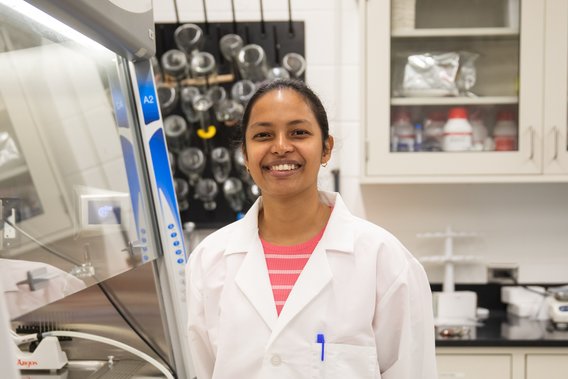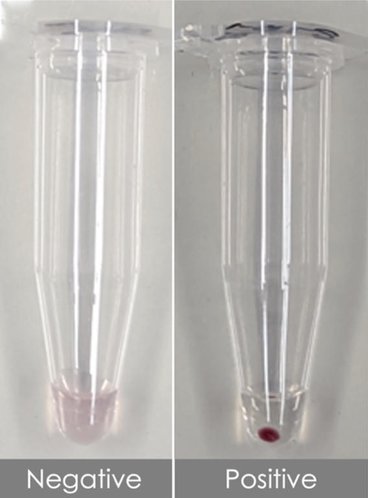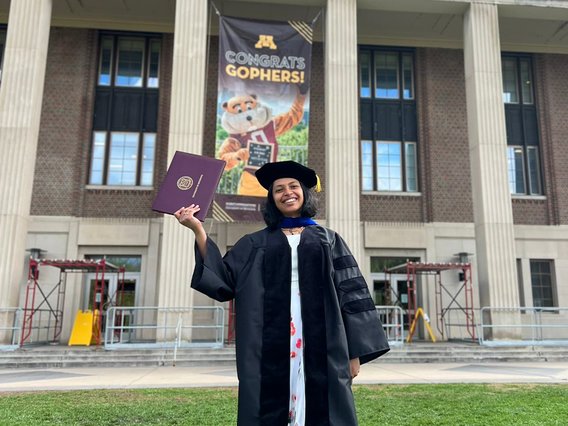Written by Carolyn Bernhardt for Minnesota Invasive Terrestrial Plants and Pests Center

Meet Vinni Thekkudan Novi, PhD, a rising star in innovative forest pathogen diagnostics. Poised to make significant contributions to her field, Thekkudan Novi is already garnering attention and recognition for a newly patented testing method she helped develop for rapid and early oak wilt detection: Loop-Mediated Isothermal Amplification, or LAMP testing.
Originally from Chennai, India, Thekkudan Novi’s journey into biotechnology began with a passion for unraveling the mysteries of science. “I've always been passionate about nature and I wanted to be a part of conserving it,” she says. “This led me to get an undergraduate degree in biotechnology, where I got interested in the making of biobased products.” Eventually, that led her to do a master's in biosystems engineering, where she first dabbled in applying her skills to combat infectious diseases.
Thekkudan Novi’s academic pursuits have taken her to leading-edge locations across the globe—from SRM University, just outside Chennai, to the labs of Michigan State University and the University of Minnesota. With a diverse background spanning research internships at esteemed institutions like the Indian Institute of Technology Madras and the National Institute of Allergy and Infectious Diseases, Thekkudan Novi brought a wealth of experience and expertise to her role as a PhD candidate in the U of M Department of Bioproducts and Biosystems Engineering.
“I chose the University of Minnesota specifically for the graduate program offered at the Department of Bioproducts and Biosystems Engineering,” says Thekkudan Novi. “It is one of the best and was on top of my list when I was applying to graduate school. Once at the U of M I quickly realized it was also a place that gave so many opportunities for networking and enhancing professional skills.”
Revolutionized detection
Thekkudan Novi defended her thesis in late March, but while in her PhD program at the U of M, she applied her vast wealth of expertise to tree conservation in Minnesota. She worked in the Abbas Lab on diagnostics for early detection and prevention of diseases, a research project supported by MITPPC through the Environment and Natural Resources Trust Fund. She helped lead the lab toward groundbreaking innovations for detecting and containing oak wilt—a fungal disease affecting oak species in Minnesota—by developing novel diagnostic approaches for rapid and early disease detection.

Thekkudan Novi’s PhD research focused on a unique application for Loop-Mediated Isothermal Amplification, or LAMP testing. LAMP tests are already valuable in fields like medical diagnostics and environmental testing due to their simplicity, speed, and accuracy. Often, researchers use LAMP testing to take a closer look at specific DNA sequences. However, Thekkudan Novi and team broke new ground when they adapted LAMP for detecting the fungus that causes oak wilt.

Traditional oak wilt testing methods are slow and cumbersome, but LAMP offers visible positive or negative results within 30 minutes with near-perfect accuracy, representing a significant improvement over conventional PCR methods in various ways.
For one thing, this groundbreaking assay is similar to PCR but notably faster. “It involves creating pathogen DNA copies at a constant temperature, unlike conventional PCR, which occurs in multiple cycles at varying temperatures,” says Thekkudan Novi. She and her team added to this process tiny gold particles covered with special DNA strands. These DNA strands are designed to stick to the DNA of a specific pathogen—in this case, the fungus responsible for oak wilt. The gold particles find the oak wilt fungus’ DNA, stick to it, and make little clusters that scientists can see as red spots. Using an approach to LAMP testing that offers a result researchers can see with the naked eye marks a paradigm shift in oak wilt disease management, allowing researchers to make timely, more cost-effective detections in the field.
Eventually, Thekkudan Novi hopes to streamline the test even further, creating a more accessible option for landowners to use themselves. Either way, by streamlining oak wilt detection with their innovative assay, Thekkudan Novi and her team are already helping reduce the economic burden oak wilt causes on Minnesotans, which is estimated at $60 million in tree removal costs alone over the past decade.
What’s next?
Thekkudan Novi says that, in the future, she sees herself applying her skillset to other fields, such as animal and human diseases. Right now, she is a postdoctoral fellow at the USDA APHIS' National Veterinary Services Laboratory in Ames, Iowa. “Here, my role is to work on improving some existing serological diagnostic tests for animal diseases, specifically in cattle and equine hosts” she says. Eventually, she hopes to move into the industry, working for a company where she can do more diagnostic test development and validation.
“What I learned at the University of Minnesota is the power of communication and the importance of asking for help when needed,” says Thekkudan Novi. “Being part of a scientific community made me feel like I'm not alone in solving the world's problems and there will always be help. We just have to be open to receiving and providing it.”

View the original story written by Carolyn Bernhardt on mitppc.umn.edu